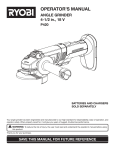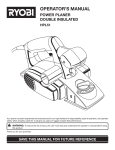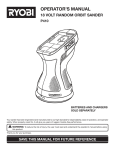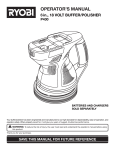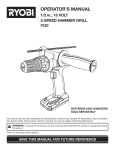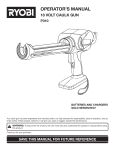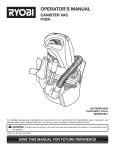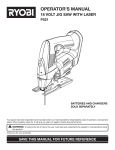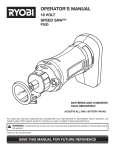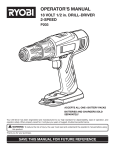Download Ryobi P610 Operator`s manual
Transcript
OPERATOR’S MANUAL 18 VOLT PLANER P610 Your planer has been engineered and manufactured to our high standard for dependability, ease of operation, and operator safety. When properly cared for, it will give you years of rugged, trouble-free performance. WARNING: To reduce the risk of injury, the user must read and understand the operator's manual before using this product. Thank you for your purchase. SAVE THIS MANUAL FOR FUTURE REFERENCE TABLE OF CONTENTS Introduction ..................................................................................................................................................................... 2 � Warranty .......................................................................................................................................................................... 2 General Safety Rules .................................................................................................................................................... 3-4 � Specific Safety Rules....................................................................................................................................................... 4 Safety Rules for Charger ................................................................................................................................................. 5 � Symbols ........................................................................................................................................................................ 6-7 � Features ........................................................................................................................................................................... 8 � Assembly ......................................................................................................................................................................... 9 � Operation .................................................................................................................................................................. 10-15 � Maintenance ............................................................................................................................................................. 16-19 � Parts Ordering / Service ................................................................................................................................................ 20 INTRODUCTION This tool has many features for making its use more pleasant and enjoyable. Safety, performance, and dependability have been given top priority in the design of this product making it easy to maintain and operate. WARRANTY RYOBI® POWER TOOL - LIMITED TWO YEAR WARRANTY AND 30 DAY EXCHANGE POLICY One World Technologies, Inc., warrants its RYOBI® power tools with the following conditions: 30-DAY EXCHANGE POLICY: During the first 30 days after date of purchase, you may either request service under this warranty or you may exchange any RYOBI® power tool which does not work properly due to defective workmanship or materials by returning the power tool to the dealer from which it was purchased. To receive a replacement power tool or requested warranty service, you must present proof of purchase and return all original equipment packaged with the original product. The replacement power tool will be covered by the limited warranty for the balance of the two year period from the date of the original purchase. WHAT THIS WARRANTY COVERS: This warranty covers all defects in workmanship or materials in your RYOBI® power tool for a period of two years from the date of purchase. With the exception of batteries, power tool accessories are warranted for ninety (90) days. Batteries are warranted for two years. HOW TO GET SERVICE: Just return the power tool, properly packaged and postage prepaid, to an Authorized Service Center. You can obtain the location of the Service Center nearest you by contacting a service representative at One World Technologies, Inc., P.O. Box 1207, Anderson, SC 29622-1207, by calling 1-800-525-2579 or by logging on to www. ryobitools.com. When you request warranty service, you must also present proof of purchase documentation, which includes the date of purchase (for example, a bill of sale). We will repair any faulty workmanship, and either repair or replace any defective part, at our option. We will do so without any charge to you. We will complete the work in a reasonable time, but, in any case, within ninety (90) days or less. WHAT’S NOT COVERED: This warranty applies only to the original purchaser at retail and may not be transferred. This warranty only covers defects arising under normal usage and does not cover any malfunction, failure or defects resulting from misuse, abuse, neglect, alteration, modification or repairs by other than Authorized Service Centers. One World Technologies, Inc. makes no warranties, representations or promises as to the quality or performance of its power tools other than those specifically stated in this warranty. ADDITIONAL LIMITATIONS: Any implied warranties granted under state law, including warranties of merchantability or fitness for a particular purpose, are limited to two years from the date of purchase. One World Technologies, Inc. is not responsible for direct, indirect, or incidental damages, so the above limitations and exclusions may not apply to you. This warranty gives you specific legal rights, and you may also have other rights which vary from state to state. 2 GENERAL SAFETY RULES Use safety equipment. Always wear eye protection. Safety equipment such as dust mask, non-skid safety shoes, hard hat, or hearing protection used for appropriate conditions will reduce personal injuries. WARNING! Read all instructions. Failure to follow all instructions listed below may result in electric shock, fire and/or serious injury. The term “power tool” in all of the warnings listed below refers to your mains-operated (corded) power tool or battery-operated (cordless) power tool. Avoid accidental starting. Ensure the switch is in the off-position before plugging in. Carrying power tools with your finger on the switch or plugging in power tools that have the switch on invites accidents. Remove any adjusting key or wrench before turning the power tool on. A wrench or a key left attached to a rotating part of the power tool may result in personal injury. Do not overreach. Keep proper footing and balance at all times. This enables better control of the power tool in unexpected situations. Dress properly. Do not wear loose clothing or jewelry. Keep your hair, clothing and gloves away from moving parts. Loose clothes, jewelry or long hair can be caught in moving parts. If devices are provided for the connection of dust extraction and collection facilities, ensure these are connected and properly used. Use of these devices can reduce dust-related hazards. Do not wear loose clothing or jewelry. Contain long hair. Loose clothes, jewelry, or long hair can be drawn into air vents. SAVE THESE INSTRUCTIONS WORK AREA SAFETY Keep work area clean and well lit. Cluttered or dark areas invite accidents. Do not operate power tools in explosive atmospheres, such as in the presence of flammable liquids, gases or dust. Power tools create sparks which may ignite the dust or fumes. Keep children and bystanders away while operating a power tool. Distractions can cause you to lose control. ELECTRICAL SAFETY Power tool plugs must match the outlet. Never modify the plug in any way. Do not use any adapter plugs with earthed (grounded) power tools. Unmodified plugs and matching outlets will reduce risk of electric shock. Avoid body contact with earthed or grounded surfaces such as pipes, radiators, ranges and refrigerators. There is an increased risk of electric shock if your body is earthed or grounded. Do not use on a ladder or unstable support. Stable footing on a solid surface enables better control of the power tool in unexpected situations. Do not expose power tools to rain or wet conditions. Water entering a power tool will increase the risk of electric shock. POWER TOOL USE AND CARE Do not force the power tool. Use the correct power tool for your application. The correct power tool will do the job better and safer at the rate for which it was designed. Do not use the power tool if the switch does not turn it on and off. Any power tool that cannot be controlled with the switch is dangerous and must be repaired. Disconnect the plug from the power source and/or the battery pack from the power tool before making any adjustments, changing accessories, or storing power tools. Such preventive safety measures reduce the risk of starting the power tool accidentally. Store idle power tools out of the reach of children and do not allow persons unfamiliar with the power tool or these instructions to operate the power tool. Power tools are dangerous in the hands of untrained users. Maintain power tools. Check for misalignment or binding of moving parts, breakage of parts and any other condition that may affect the power tool’s operation. If damaged, have the power tool repaired before use. Many accidents are caused by poorly maintained power tools. Keep cutting tools sharp and clean. Properly maintained cutting tools with sharp cutting edges are less likely to bind and are easier to control. Do not abuse the cord. Never use the cord for carrying, pulling or unplugging the power tool. Keep cord away from heat, oil, sharp edges or moving parts. Damaged or entangled cords increase the risk of electric shock. When operating a power tool outdoors, use an extension cord suitable for outdoor use. Use of a cord suitable for outdoor use reduces the risk of electric shock. Use battery only with charger listed. MODEL BATTERY PACK (P100) CHARGER (P110) P610 130255004 1423701, 140237021, or 130224028 or 140237023 PERSONAL SAFETY Stay alert, watch what you are doing and use common sense when operating a power tool. Do not use a power tool while you are tired or under the influence of drugs, alcohol or medication. A moment of inattention while operating power tools may result in serious personal injury. 3 GENERAL SAFETY RULES Use the power tool, accessories and tool bits etc., in accordance with these instructions and in the manner intended for the particular type of power tool, taking into account the working conditions and the work to be performed. Use of the power tool for operations different from those intended could result in a hazardous situation. connection from one terminal to another. Shorting the battery terminals together may cause burns or a fire. Under abusive conditions, liquid may be ejected from the battery, avoid contact. If contact accidentally occurs, flush with water. If liquid contacts eyes, additionally seek medical help. Liquid ejected from the battery may cause irritation or burns. BATTERY TOOL USE AND CARE SERVICE Ensure the switch is in the off position before inserting battery pack. Inserting the battery pack into power tools that have the switch on invites accidents. Have your power tool serviced by a qualified repair person using only identical replacement parts. This will ensure that the safety of the power tool is maintained. Recharge only with the charger specified by the manufacturer. A charger that is suitable for one type of battery pack may create a risk of fire when used with another battery pack. WARNING! To reduce the risk of injury, user must read instruction manual. Use power tools only with specifically designated battery packs. Use of any other battery packs may create a risk of injury and fire. When servicing a power tool, use only identical replacement parts. Follow instructions in the Maintenance section of this manual. Use of unauthorized parts or failure to follow Maintenance instructions may create a risk of shock or injury. When battery pack is not in use, keep it away from other metal objects like paper clips, coins, keys, nails, screws, or other small metal objects that can make a SPECIFIC SAFETY RULES Wait for the cutter to stop before setting the tool down. An exposed cutter may engage the surface leading to possible loss of control and serious injury. Use clamps or another practical way to secure and support the workpiece to a stable platform. Holding the work by hand or against your body leaves it unstable and may lead to loss of control. Hold power tools by insulated gripping surfaces when performing an operation where the cutting tool may contact hidden wiring or its own cord. Contact with a “live” wire will also make exposed metal parts of the tool “live” and shock the operator. Know your power tool. Read operator’s manual carefully. Learn its applications and limitations, as well as the specific potential hazards related to this power tool. Following this rule will reduce the risk of electric shock, fire, or serious injury. Always wear safety glasses with side shields. Everyday glasses have only impact resistant lenses. They are NOT safety glasses. Following this rule will reduce the risk of eye injury. Protect your lungs. Wear a face or dust mask if the operation is dusty. Following this rule will reduce the risk of serious personal injury. Protect your hearing. Wear hearing protection during extended periods of operation. Following this rule will reduce the risk of serious personal injury. Battery tools do not have to be plugged into an electrical outlet; therefore, they are always in operating condition. Be aware of possible hazards when not using your battery tool or when changing 4 accessories. Following this rule will reduce the risk of electric shock, fire, or serious personal injury. Do not place battery tools or their batteries near fire or heat. This will reduce the risk of explosion and possibly injury. Never use a battery that has been dropped or received a sharp blow. A damaged battery is subject to explosion. Properly dispose of a dropped or damaged battery immediately. Batteries vent hydrogen gas and can explode in the presence of a source of ignition, such as a pilot light. To reduce the risk of serious personal injury, never use any cordless product in the presence of open flame. An exploded battery can propel debris and chemicals. If exposed, flush with water immediately. Do not charge battery tool in a damp or wet location. Following this rule will reduce the risk of electric shock. For best results, your battery tool should be charged in a location where the temperature is more than 50°F but less than 100°F. Do not store outside or in vehicles. Under extreme usage or temperature conditions, battery leakage may occur. If liquid comes in contact with your skin, wash immediately with soap and water, then neutralize with lemon juice or vinegar. If liquid gets into your eyes, flush them with clean water for at least 10 minutes, then seek immediate medical attention. Following this rule will reduce the risk of serious personal injury. SAFETY RULES FOR CHARGER An extension cord should not be used unless absolutely necessary. Use of improper extension cord could result in a risk of fire and electric shock. If extension cord must be used, make sure: WARNING! READ AND UNDERSTAND ALL INSTRUCTIONS. Failure to follow all instructions listed below, may result in electric shock, fire and/or serious personal injury. a. That pins on plug of extension cord are the same number, size and shape as those of plug on charger. Before using battery charger, read all instructions and cautionary markings in this manual, on battery charger, battery, and product using battery to prevent misuse of the products and possible injury or damage. b. That extension cord is properly wired and in good electrical condition; and c. That wire size is large enough for AC ampere rating of charger as specified below: CAUTION: To reduce the risk of electric shock or damage to the charger and battery, charge only nickel-cadmium rechargeable batteries as specifically designated on your charger. Other types of batteries may burst, causing personal injury or damage. Cord Length (Feet) 25' 50' 100' Cord Size (AWG) 16 16 16 NOTE: AWG = American Wire Gauge Do not operate charger with a damaged cord or plug, which could cause shorting and electric shock. If damaged, have the charger replaced by an authorized serviceman. Do not operate charger if it has received a sharp blow, been dropped, or otherwise damaged in any way. Take it to an authorized serviceman for electrical check to determine if the charger is in good working order. Do not use charger outdoors or expose to wet or damp conditions. Water entering charger will increase the risk of electric shock. Use of an attachment not recommended or sold by the battery charger manufacturer may result in a risk of fire, electric shock, or injury to persons. Following this rule will reduce the risk of electric shock, fire, or serious personal injury. Do not disassemble charger. Take it to an authorized serviceman when service or repair is required. Incorrect reassembly may result in a risk of electric shock or fire. Unplug charger from outlet before attempting any maintenance or cleaning to reduce the risk of electric shock. Do not abuse cord or charger. Never use the cord to carry the charger. Do not pull the charger cord rather than the plug when disconnecting from receptacle. Damage to the cord or charger could occur and create an electric shock hazard. Replace damaged cords immediately. Disconnect charger from the power supply when not in use. This will reduce the risk of electric shock or damage to the charger if metal items should fall into the opening. It also will help prevent damage to the charger during a power surge. Make sure cord is located so that it will not be stepped on, tripped over, come in contact with sharp edges or moving parts or otherwise subjected to damage or stress. This will reduce the risk of accidental falls, which could cause injury, and damage to the cord, which could result in electric shock. Risk of electric shock. Do not touch uninsulated portion of output connector or uninsulated battery terminal. Save these instructions. Refer to them frequently and use them to instruct others who may use this tool. If you loan someone this tool, loan them these instructions also to prevent misuse of the product and possible injury. Keep cord and charger from heat to prevent damage to housing or internal parts. Do not let gasoline, oils, petroleum-based products, etc. come in contact with plastic parts. They contain chemicals that can damage, weaken, or destroy plastic. IMPORTANT SAFETY INSTRUCTIONS 1. SAVE THESE INSTRUCTIONS 2. 3. This manual contains important safety and operating instructions for battery charger. Before using battery charger, read all instructions and cautionary markings on battery charger, battery, and product using battery. CAUTION: To reduce the risk of injury, charge only nickel-cadmium rechargeable batteries. Other types of batteries may burst, causing personal injury or damage. 5 SYMBOLS Some of the following symbols may be used on this tool. Please study them and learn their meaning. Proper interpretation of these symbols will allow you to operate the tool better and safer. SYMBOL NAME DESIGNATION/EXPLANATION V Volts Voltage A Amperes Current Hz Hertz Frequency (cycles per second) W Watt Power Minutes Time Alternating Current Type of current Direct Current Type or a characteristic of current No Load Speed Rotational speed, at no load Class II Construction Double-insulated construction Per Minute Revolutions, strokes, surface speed, orbits etc., per minute Wet Conditions Alert Do not expose to rain or use in damp locations. Read The Operator’s Manual To reduce the risk of injury, user must read and understand operator’s manual before using this product. Eye Protection Always wear safety goggles or safety glasses with side shields and, as necessary, a full face shield when operating this product. Safety Alert Precautions that involve your safety. No Hands Symbol Failure to keep your hands away from the blade will result in serious personal injury. No Hands Symbol Failure to keep your hands away from the blade will result in serious personal injury. No Hands Symbol Failure to keep your hands away from the blade will result in serious personal injury. No Hands Symbol Failure to keep your hands away from the blade will result in serious personal injury. Hot Surface To reduce the risk of injury or damage, avoid contact with any hot surface. min no .../min 6 SYMBOLS The following signal words and meanings are intended to explain the levels of risk associated with this product. SYMBOL SIGNAL MEANING DANGER: Indicates an imminently hazardous situation, which, if not avoided, will result in death or serious injury. WARNING: Indicates a potentially hazardous situation, which, if not avoided, could result in death or serious injury. CAUTION Indicates a potentially hazardous situation, which, if not avoided, may result in minor or moderate injury. CAUTION (Without Safety Alert Symbol) Indicates a situation that may result in property damage. SERVICE WARNING: Servicing requires extreme care and knowledge and should be performed only by a qualified service technician. For service we suggest you return the product to the nearest AUTHORIZED SERVICE CENTER for repair. When servicing, use only identical replacement parts. To avoid serious personal injury, do not attempt to use this product until you read thoroughly and understand completely the operator’s manual. If you do not understand the warnings and instructions in the operator’s manual, do not use this product. Call Ryobi customer service for assistance. WARNING: The operation of any power tool can result in foreign objects being thrown into your eyes, which can result in severe eye damage. Before beginning power tool operation, always wear safety goggles or safety glasses with side shields and, when needed, a full face shield. We recommend Wide Vision Safety Mask for use over eyeglasses or standard safety glasses with side shields. Always use eye protection which is marked to comply with ANSI Z87.1. SAVE THESE INSTRUCTIONS 7 FEATURES PRODUCT SPECIFICATIONS Rabbet Depth .........................................................0-1/2 in. Charger Input ................................... 120 V, 60 Hz, AC only Charge Rate ..............................................................1 hour Motor .................................................................. 18 Volt DC No Load Speed ................................................ 10,000/min. Planing Width ............................................................... 2 in. Planing Depth .......................................................... 1/64 in. DUST BAG EDGE GUIDE/ RABBET GUIDE LOCK-OFF BUTTON BLADE WRENCH REVERSIBLE BLADES DEPTH ADJUSTMENT KNOB SWITCH TRIGGER KICKSTAND Fig. 1 KNOW YOUR PLANER EDGE GUIDE/RABBET GUIDE See Figure 1. The safe use of this product requires an understanding of the information on the tool and in this operator’s manual as well as a knowledge of the project you are attempting. Before use of this product, familiarize yourself with all operating features and safety rules. The edge guide may be attached for planing edges and making rabbet cuts. KICKSTAND BLADE WRENCH The lock-off button locks the switch trigger in the OFF position when the switch is released. The kickstand allows the planer to sit on a workpiece or table without damaging the surface or the blades. LOCK-OFF BUTTON A blade wrench is included for convenience in changing blades. REVERSIBLE BLADES DEPTH ADJUSTMENT KNOB The blades installed on your planer can be reversed for longer life between blade changes. An additional set of blades is included. The planing depth can be adjusted from 0 to 1/64 in. DUST BAG The dust bag attaches to the exhaust of the planer to keep the work area free of debris. A 1-1/4 in. vacuum hose can also be attached for dust collection. 8 ASSEMBLY UNPACKING ATTACHING THE PLANER TO A VACUUM This product has been shipped completely assembled. See Figure 3. The chip collection system of the planer has a 1-1/4 in. port for inserting a vacuum hose. Remove the battery pack from the tool. Carefully remove the tool and any accessories from the box. Make sure that all items listed in the packing list are included. Inspect the tool carefully to make sure no breakage or damage occurred during shipping. Remove the dust bag. Do not discard the packing material until you have carefully inspected and satisfactorily operated the tool. Connect the vacuum to a power supply. Attach a vacuum hose to the chip exhaust. If any parts are damaged or missing, please call 1-800-525-2579 for assistance. DUST BAG ADAPTOR PACKING LIST Planer (with blades installed) Reversible Blades (2) Edge Guide/Rabbet Guide Blade Wrench Dust Bag Lanyard (not included in combo) Operator’s Manual WARNING: If any parts are damaged or missing do not operate this tool until the parts are replaced. Failure to heed this warning could result in serious personal injury. Fig. 2 WARNING: WARNING: When the tool is not connected to vacuum, always reinstall the dust bag back onto the tool. Failure to do so could cause dust or foreign objects to be thrown into your face or eyes, which could result in possible serious injury. Do not attempt to modify this tool or create accessories not recommended for use with this tool. Any such alteration or modification is misuse and could result in a hazardous condition leading to possible serious personal injury. WARNING: To prevent accidental starting that could cause serious personal injury, always remove the battery pack from the tool when assembling parts. INSTALLING/REMOVING THE DUST BAG See Figure 2. The dust bag located on the right side of the hand planer provides a dust collection system. Wood particles are drawn up through the base and collect in the dust bag during operation. For more efficient operation, empty the dust bag when half full. To install, slide the dust bag adaptor onto the chip exhaust on the planer. To remove the dust bag, grasp the adaptor and pull the dust bag away from the planer. Fig. 3 9 OPERATION NOTE: Batteries will not reach full charge the first time they are charged. Allow several cycles (operation followed by recharging) for them to become fully charged. WARNING: Do not allow familiarity with tools to make you careless. Remember that a careless fraction of a second is sufficient to inflict serious injury. CHARGING A COOL BATTERY PACK If battery pack is within normal temperature range, the red LED on charger will come on. NOTE: If the charger does not charge the battery pack under normal circumstances, return both the battery pack and charger to your nearest Authorized Service Center for electrical check. Charge the battery pack only with the charger provided. Make sure the power supply is normal household voltage, 120 volts, 60 Hz, AC only. Connect the charger to the power supply. Place the battery pack in the charger aligning raised rib on the battery pack with the groove in the charger. See Figure 4. Press down on the battery pack to be sure contacts on the battery pack engage properly with contacts in the charger. Normally the red LED on charger will come on. This indicates the charger is in fast charging mode. Red LED should remain on for approximately 1 hour then the green LED will come on. Green LED on indicates battery pack is fully charged and charger is in maintenance charge mode. NOTE: The green LED will remain on until the battery pack is removed from the charger or charger is disconnected from the power supply. If both yellow and green LEDs come on, this indicates a deeply discharged or defective battery pack. Allow the battery pack to remain in the charger for 15 to 30 minutes. When the battery pack reaches normal voltage range, the red LED should come on. If the red LED does not come on after 30 minutes, this may indicate a defective battery pack that should be replaced. After normal usage, a minimum of 1 hour of charging time is required to fully recharge battery pack. The battery pack will become slightly warm to the touch while charging. This is normal and does not indicate a problem. Do not place the charger and battery pack in an area of extreme heat or cold. They will work best at normal room temperature. NOTE: The charger and battery pack should be placed in a location where the temperature is more than 50°F but less than 100°F. When batteries become fully charged, unplug the charger from power supply and remove the battery pack. WARNING: Always wear safety goggles or safety glasses with side shields when operating tools. Failure to do so could result in objects being thrown into your eyes, resulting in possible serious injury. WARNING: Do not use any attachments or accessories not recommended by the manufacturer of this tool. The use of attachments or accessories not recommended can result in serious personal injury. APPLICATIONS You may use this tool for the purposes listed below: Planing the edge of a wooden door or shelf Planing the edge of a piece of lumber Making rabbet cuts in wood CAUTION: If at any point during the charging process none of the LEDs are lit, remove the battery pack from the charger to avoid damaging the product. DO NOT insert another battery. Return the charger and battery to your nearest service center for service or replacement. LED FUNCTIONS OF CHARGER LED WILL BE ON TO INDICATE STATUS OF CHARGER AND BATTERY PACK: Red LED on = Fast charging mode. Green LED on = Fully charged and in maintenance charge mode. Green LED on = When battery pack is inserted into charger, indicates hot battery pack or that battery pack is out of normal temperature range. Yellow and Green LEDs on = Deeply discharged or defective battery pack. No LED on = Defective charger or battery pack. CHARGING THE BATTERY PACK The battery pack for this tool has been shipped in a low charge condition to prevent possible problems. Therefore, you should charge it until the green LED on the front of the charger comes on. 10 OPERATION CHARGING A HOT BATTERY PACK BATTERY PACK SHOWN IN CHARGER When using the tool continuously, the batteries in the battery pack will become hot. You should let a hot battery pack cool down for approximately 30 minutes before attempting to recharge. When the battery pack becomes discharged and is hot, this will cause the green LED to come on instead of the red LED. After 30 minutes, reinsert the battery pack in the charger. If the green LED continues to remain on, return battery pack to your nearest Authorized Service Center for checking or replacing. NOTE: This situation only occurs when continuous use of the tool causes the batteries to become hot. It does not occur under normal circumstances. Refer to CHARGING A COOL BATTERY PACK for normal recharging of batteries. If the charger does not charge your battery pack under normal circumstances, return both the battery pack and charger to your nearest Authorized Service Center for electrical check. P110 CHARGER P100 BATTERY PACK YELLOW LED TO INSTALL BATTERY PACK See Figure 5. Place the lock-off button in the center position to lock the switch. Place the battery pack in the tool. Align raised rib on battery pack with the groove inside the tool. Slide the battery pack into the tool until the latches on each side of the battery pack snap into place and battery pack is secured in the tool before beginning operation. RED LED GREEN LED Fig. 4 BATTERY PACK CAUTION: When placing battery pack in the tool, be sure raised rib on battery pack aligns with the battery port of the planer and latches into place properly. Improper installation of the battery pack can cause damage to internal components. LATCH TO REMOVE BATTERY PACK See Figure 5. Place the lock-off button in the center position to lock the switch. Locate latches on side of battery pack and depress to release battery pack from the tool. The battery pack will automatically disconnect when buttons are depressed. Remove the battery pack from the tool. Fig. 5 11 OPERATION WARNING: SWITCH TRIGGER LOCK-OFF BUTTON Battery tools are always in operating condition. Therefore, switch should always be locked when not in use or carrying at your side. STARTING/STOPPING THE PLANER See Figure 6. To start the planer: Push the lock-off button from either side, and then depress the switch trigger. To stop the planer: Release the switch trigger. KICKSTAND See Figure 7. The planer has been equipped with an automatic pivoting kickstand that will prevent the blade from contacting the workbench when not in use. As you begin your planing operation, the kickstand will automatically retract as it passes over the edge of the workpiece. When setting the planer down on your workbench, the kickstand will automatically pivot down to prevent the blade from making any contact. Fig. 6 KICKSTAND WARNING: Make sure the kickstand operates freely at all times and that the area surrounding the kickstand is clear of debris. Failure to do so could result in serious personal injury. PLANING DEPTH See Figure 8. When you begin planing a rough piece of material, the planer will only remove the high spots at first. Successive passes will remove more and more material. By removing no more than 1/64 in. with each pass, you will achieve the smoothest finish, even from the roughest workpiece. Always begin by making test cuts in scrap wood to make sure that the planer is removing the desired amount of wood. To set the planing depth: Lock the switch by placing the lock-off button in the center position. WORKPIECE 1 64 m) (0.4m NOTE: The switch automatically locks when not depressed to the left or the right. Fig. 7 Turn the depth adjustment knob clockwise to reach the maximum depth of cut. DEPTH ADJUSTMENT KNOB NOTE: To protect the blades during storage, transporting, etc., set the depth adjustment to 0. DEPTH ADJUSTMENT SCALE Fig. 8 12 OPERATION FRONT HANDLE WARNING: Always clamp the workpiece securely before making a cut. Work moving during a cut could result in loss of control of the planer and cause serious injury. OPERATING THE PLANER REAR HANDLE See Figure 9. Clamp the work securely. Support the work so that the operation is on your right. Adjust the planing depth. Hold the planer with both hands. Hold the front handle with your left hand and the rear handle with your right hand. WARNING: Always use two hands on the tool for any operation. This assures that you maintain control and avoid risk of serious personal injury. Always properly support and clamp the work so that both hands are free to control the planer. DUST BAG Place the front shoe on the edge of work to be planed. VISE NOTE: Make sure the blades are not touching the work. Apply pressure to the front handle so that the front shoe is completely flat on the work. WORKPIECE Fig. 9 Start the planer and let the motor reach maximum speed. Hold the planer firmly and push it forward into the work, using a slow, steady motion. CAUTION: Planing too fast results in a poor finish and increases chip build-up in the chip exhaust. Chip build-up restricts air flow and can cause motor overheating. Apply downward pressure toward the rear handle as you reach the end of the planed cut. This helps keep the rear section of the planer base in contact with the work and prevents the front of the planer from gouging the cut. WARNING: WARNING: Do not attempt to clear a blocked chip exhaust until the blades stop and you have removed the battery. Failure to heed this warning can result in serious personal injury. Be careful to avoid hitting nails or any other foreign objects during planing operation; this action could nick, crack, or damage blades. NOTE: We suggest that you always keep an extra set of blades on hand. If the blades in the planer show signs of becoming dull, chipped, or damaged in any way, replace them. The blades are reversible and can be reversed until both sides become dull. Reverse or change the blades only as a set, never individually. Plane slowly and empty the dust bag often. NOTE: Using a battery in a low charge condition will cause chip build-up and clogging of the chip exhaust. This will also affect the quality of the cut. Keep a freshly charged battery available and replace the discharged battery when you notice a decrease in performance. 13 OPERATION CHAMFERING GROOVE See Figure 10. The planer is designed with a chamfering groove in the front shoe to chamfer edges of boards as shown. Before making a cut on good lumber, practice cutting on scrap lumber to determine the amount to be removed. Clamp the work securely. Hold the front handle with your left hand and the rear handle with your right hand. Place the chamfering groove on the surface to be cut. Start the planer and let the motor reach maximum speed. Hold the planer firmly and push it forward into the work, using a slow, steady motion. FRONT HANDLE Apply downward pressure to keep the planer flat at the beginning and the end of the work surface. PLANING EDGES AND MAKING RABBET CUTS WORKPIECE The planer comes with an adjustable edge guide for precision edge planing and rabbet cutting. Attach the edge guide to either side of the planer for planing edges. Attach the edge guide to the left side for making rabbet cuts. VISE ATTACHING THE EDGE GUIDE FOR PLANING EDGES Fig. 10 See Figure 11. Lock the switch by placing the lock-off button in the center position. Remove the battery pack from the tool. CARRIAGE HEAD BOLT Attach the bracket to the desired side of the planer using the knob bolt. Attach the edge guide to the bracket using the knob nut and the carriage head bolt. KNOB BOLT Tighten the knob bolt and knob nut securely. BRACKET EDGE GUIDE KNOB NUT Fig. 11 14 OPERATION PLANING EDGES See Figure 12. Follow the directions in Operating the Planer. Hold the edge guide firmly against the edge of the work surface. ATTACHING THE EDGE GUIDE FOR MAKING RABBET CUTS Lock the switch by placing the lock-off button in the center position. Remove the battery pack from the tool. Attach the bracket to the left side of the planer using the knob bolt. Attach the edge guide loosely to the bracket using the knob nut and the carriage head bolt. Adjust the edge guide to the desired width for the rabbet cut. Tighten the retaining knob securely. EDGE GUIDE MAKING RABBET CUTS WORKPIECE See Figure 13. Follow the directions in the Operating the Planer section earlier in this manual. Hold the edge guide firmly against the edge of the work surface. The depth of the rabbet is determined by the depth of the cut and the number of passes made along the work surface. The maximum depth of the rabbet cut is 1/2 in. Cuts should be made in passes of 1/64 in. or less to reach the desired depth. The width of the rabbet cut may be adjusted by moving the edge guide. Fig. 12 EDGE GUIDE WORKPIECE 15 Fig. 13 MAINTENANCE GENERAL MAINTENANCE WARNING: Avoid using solvents when cleaning plastic parts. Most plastics are susceptible to damage from various types of commercial solvents and may be damaged by their use. Use clean cloths to remove dirt, dust, oil, grease, etc. When servicing, use only identical replacement parts. Use of any other parts may create a hazard or cause product damage. WARNING: WARNING: Do not at any time let brake fluids, gasoline, petroleumbased products, penetrating oils, etc., come in contact with plastic parts. Chemicals can damage, weaken or destroy plastic which may result in serious personal injury. Always wear safety goggles or safety glasses with side shields during power tool operation or when blowing dust. If operation is dusty, also wear a dust mask. WARNING: Only the parts shown on the parts list are intended to be repaired or replaced by the customer. All other parts should be replaced at an Authorized Service Center. To avoid serious personal injury, always remove the battery pack from the tool when cleaning or performing any maintenance. BATTERY PACK REMOVAL AND PREPARATION FOR RECYCLING BATTERIES The battery pack for this tool is equipped with nickel-cadmium rechargeable batteries. Length of service from each charging will depend on the type of work you are doing. The batteries in this tool have been designed to provide maximum trouble-free life. However, like all batteries, they will eventually wear out. Do not disassemble battery pack and attempt to replace the batteries. Handling of these batteries, especially when wearing rings and jewelry, could result in a serious burn. To obtain the longest possible battery life, we suggest the following: Remove the battery pack from the charger once it is fully charged and ready for use. To preserve natural resources, please re c yc l e or di spose of ba tte ri e s properly. This product contains nickel-cadmium batteries. Local, state or federal laws may prohibit disposal of nickel-cadmium batteries in ordinary trash. Consult your local waste authority for information regarding available recycling and/or disposal options. WARNING: Upon removal, cover the battery pack’s terminals with heavy-duty adhesive tape. Do not attempt to destroy or disassemble battery pack or remove any of its components. Nickel-cadmium batteries must be recycled or disposed of properly. Also, never touch both terminals with metal objects and/or body parts as short circuit may result. Keep away from children. Failure to comply with these warnings could result in fire and/or serious injury. For battery storage longer than 30 days: Store the battery pack where the temperature is below 80°F. Store battery packs in a “discharged” condition. 16 MAINTENANCE CHANGING BLADES See Figures 14 - 16. The planer blades are reversible. When one edge becomes dull, the blade can be reversed so that the other side can be used. Always replace or reverse blades in pairs. Do not attempt to sharpen blades. If the blades in the planer show signs of becoming dull, chipped, or damaged in any way, replace them. When changing blades, use the recommended replacement blades only (Part No. 671798001). BLADE WRENCH BLADE CLAMP SCREWS WARNING: The blades are sharp. Use extreme caution when replacing blades. Failure to heed this warning can result in serious personal injury. Fig. 14 Remove the battery pack from the tool. REMOVING THE OLD BLADE Secure the planer in an upside-down position. Loosen the two screws securing the blade and blade clamp on the blade holder using the blade wrench provided. Loosen the screws just enough to remove the old blade. NOTE: If screws are too loose, alignment of the new blade will not be accurate. NOTE: Before removing the old blades, take notice of the direction of cut as well as how the tapered edge of the old blades are oriented. The tapered edge of the new blades must be in the same orientation as the original blades, with the tapered edge on the same side as the screw heads and the flat edge facing the cutter block. CUTTER BLOCK Fig. 15 BLADE HOLDER SLOT Push the blade (to the right) out of the blade holder using the tip of a screwdriver. Remove the old blade from the blade holder. NOTE: If you cannot easily push the blade out of the blade holder after loosening the screws, use a block of wood to break the blade loose from the blade holder. Give the blade a short, sharp blow, then push it with a screwdriver to remove. If necessary, tap the block of wood sharply with a small hammer to break the blades loose. INSERTING THE NEW BLADE Clean any sawdust or wood chips from around the blade area. Slide the new blade into the slot of the blade holder. Use a screwdriver to push the blade into the blade holder until it is centered into position. Tighten the two screws using the blade wrench. Repeat the above procedure to change the other blade. Fig. 16 17 MAINTENANCE REPLACING THE BELT See Figures 17 - 18. When replacing the belt, use recommended replacement belt only (Part No. 570279002). Remove the battery pack from the tool. Remove the belt cover screws. Remove the belt cover. Force the old belt from the small pulley by turning in the direction shown. As you turn the belt, pull and work it off the small pulley until it has been completely removed from both pulleys. Install the new belt over the large pulley. As you turn the belt, push and work it onto the small pulley until it is in place. Make sure the belt is flush with the edge of both pulleys. Replace the belt cover. Install the belt cover screws and tighten securely. NOTE: Do not overtighten the screws. SCREWS Fig. 17 BELT COVER SMALL PULLEY LARGE PULLEY 18 Fig. 18 MAINTENANCE CLEANING THE CHIP EXHAUST AND EMPTYING THE DUST BAG See Figure 19. After using the planer for an extended period of time or when planing wet or green lumber, chips may build up in the chip exhaust. Chip build-up restricts air flow and causes the motor to overheat. Clean the chip exhaust port and empty the dust bag regularly. Remove the battery pack from the tool. CHIP EXHAUST Remove the dust bag from the chip exhaust. Clean the build-up from the chip exhaust port with a small piece of wood. Do not use your hands or fingers. Unzip the dust bag. Empty all debris from the dust bag and ensure that the collar is free of debris. Replace the dust bag. DUST BAG Fig. 19 19 OPERATOR’S MANUAL 18 VOLT PLANER P610 WARNING: Some dust created by power sanding, sawing, grinding, drilling, and other construction activities contains chemicals known to cause cancer, birth defects or other reproductive harm. Some examples of these chemicals are: • lead from lead-based paints, • crystalline silica from bricks and cement and other masonry products, and • arsenic and chromium from chemically-treated lumber. Your risk from these exposures varies, depending on how often you do this type of work. To reduce your exposure to these chemicals: work in a well ventilated area, and work with approved safety equipment, such as those dust masks that are specially designed to filter out microscopic particles. • SERVICE Now that you have purchased your tool, should a need ever exist for repair parts or service, simply contact your nearest Authorized Service Center. Be sure to provide all pertinent facts when you call or visit. Please call 1-800-525-2579 for your nearest Authorized Service Center. You can also check our web site at www.ryobitools.com for a complete list of Authorized Service Centers. • MODEL NO. AND SERIAL NO. The model number of this tool will be found on a plate attached to the motor housing. Please record the model number and serial number in the space provided below. • HOW TO ORDER REPAIR PARTS When ordering repair parts, always give the following information: • MODEL NUMBER • SERIAL NUMBER P610 Ryobi® is a registered trademark of Ryobi Limited used under license. ONE WORLD TECHNOLOGIES, INC. 1428 Pearman Dairy Road, Anderson, SC 29625 Phone 1-800-525-2579 www.ryobitools.com 983000-936 1-30-06 (REV:00) 20




















